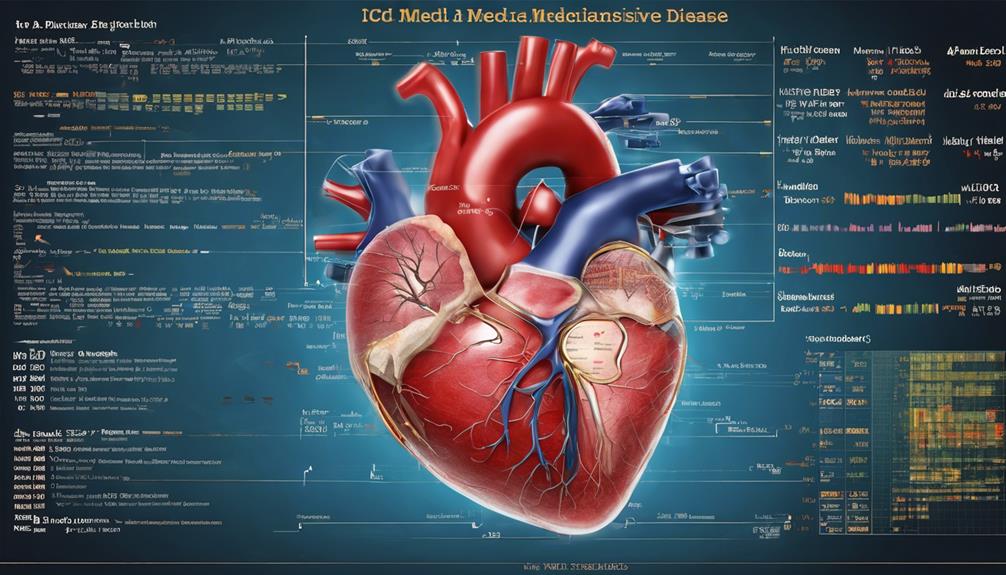Let’s discuss strategies for dealing with the challenges of coding for atherosclerotic heart disease using ICD-10. Understanding the details and implications of the I25.10 code is crucial when exploring this subject.
Understanding this specific code is just the tip of the iceberg when it comes to accurately categorizing and managing atherosclerotic heart disease cases.
In the ever-evolving landscape of healthcare documentation, staying informed on the latest updates and guidelines for ICD-10 coding is paramount for ensuring precise patient care and outcomes.
Key Takeaways
- Accurate ICD-10 coding crucial for atherosclerotic heart disease diagnosis.
- Comprehensive documentation essential for precise billing and treatment.
- Utilize specific codes like I25.10 for accurate record-keeping.
- Follow coding guidelines diligently for precise code assignment.
Understanding Atherosclerotic Heart Disease ICD-10 Codes
Understanding the ICD-10 codes for atherosclerotic heart disease is essential for accurate medical coding and billing practices in healthcare. When it comes to atherosclerotic heart disease involving the coronary artery, proper documentation is crucial.
The ICD-10 code I25.10 specifically addresses atherosclerotic heart disease of the native coronary artery without angina pectoris. This code is used to classify and track instances of atherosclerosis in the coronary arteries, which are vital blood vessels supplying the heart muscle.
It's imperative to pay attention to additional codes that can further specify related conditions such as chronic total occlusion of coronary arteries or exposure to environmental tobacco smoke. By understanding the nuances of coding for atherosclerotic heart disease, healthcare professionals ensure accurate billing and comprehensive patient records.
Utilizing the correct codes not only aids in proper documentation but also helps in providing appropriate care based on the specific condition affecting the coronary arteries.
Coding Atherosclerotic Heart Disease Diagnosis

When diagnosing atherosclerotic heart disease, accurately assigning the ICD-10 code I25.10 is crucial for precise medical coding and billing practices. This specific code pertains to atherosclerotic heart disease of native coronary arteries without angina pectoris.
Here are essential points to consider when coding for atherosclerotic heart disease involving coronary arteries and blood vessels:
- Utilize additional codes: Specify details like chronic total occlusion of coronary arteries or comorbidities such as tobacco dependence to provide a comprehensive picture.
- Ensure accuracy: Correctly using ICD-10 code I25.10 is fundamental for precise medical documentation and billing processes.
- Follow coding guidelines: Understanding the specific guidelines for atherosclerotic heart disease diagnosis aids in accurate code assignment.
- Cross-reference diligently: Verify related codes and documentation to capture all relevant information and ensure thorough coding accuracy in cases involving coronary arteries and blood vessels.
Differentiating ICD-10 Codes for Heart Disease
Distinguishing between various ICD-10 codes is essential for accurately coding heart disease diagnoses. When dealing with conditions like atherosclerotic heart disease, it's crucial to differentiate between specific codes to provide precise medical documentation. For instance, ICD-10 code I25.10 indicates atherosclerotic heart disease of the native coronary artery without angina pectoris. This code must be used carefully to avoid confusion with other related conditions like atheroembolism or atherosclerosis of coronary artery bypass graft(s).
In conjunction with I25.10, additional codes such as I25.83 and I25.84 play a vital role in identifying specific types of coronary atherosclerosis. Understanding coding guidance for conditions like chronic total occlusion of coronary arteries or tobacco dependence is also essential for accurate I25.10 coding. By utilizing the correct ICD-10 codes, healthcare providers ensure accurate billing and meticulous record-keeping for patients with coronary artery issues related to atherosclerotic heart disease.
Billing for Atherosclerotic Heart Disease Treatment

Properly selecting the correct ICD-10 code is crucial when billing for the treatment of atherosclerotic heart disease, ensuring accurate documentation for reimbursement purposes. When coding for atherosclerotic heart disease treatment, consider the following key points:
- Utilize specific ICD-10 codes like I25.10 to denote atherosclerotic heart disease of native coronary artery without angina pectoris.
- Include additional codes for pertinent details such as chronic total occlusion of coronary artery, exposure to environmental tobacco smoke, or history of tobacco dependence.
- Ensure comprehensive documentation and accurate coding to facilitate proper billing and reimbursement processes for atherosclerotic heart disease treatment.
- Stay updated on coding guidelines and regulations to maintain compliance in billing practices related to atherosclerotic heart disease.
Proper billing practices not only aid in reimbursement but also contribute to improved healthcare services for patients by enabling healthcare providers to deliver quality care for conditions affecting blood vessels and the circulation of oxygen-rich blood.
Managing Atherosclerotic Heart Disease Records
Maintaining accurate and detailed medical records for atherosclerotic heart disease is crucial for effective diagnosis and treatment planning. When documenting atherosclerosis, it is essential to include specifics such as the type and severity of the condition, associated symptoms, and relevant risk factors. This information is vital for healthcare providers to monitor disease progression, evaluate treatment efficacy, and make well-informed clinical decisions regarding the heart and vessels.
To better illustrate the importance of meticulous record-keeping, consider the following table:
| Record Details | Importance |
|---|---|
| Type of Atherosclerosis | Guides treatment approaches |
| Symptom Description | Aids in symptom management and risk assessment |
| Risk Factor Analysis | Helps in prevention strategies and monitoring |
Frequently Asked Questions
What Is the ICD-10 Code for Atherosclerosis of the Heart?
We found the ICD-10 code for atherosclerosis of the heart. It's important to accurately code and bill for this condition using I25.10. This code helps in classifying and tracking atherosclerotic heart disease cases for medical and statistical purposes.
What Is the Difference Between I25 118 and I25 119?
We'll break it down for you:
I25.118 specifies atherosclerotic heart disease of the native coronary artery with other forms of angina pectoris, whereas I25.119 indicates the same heart disease but with unspecified angina pectoris.
Knowing these distinctions is vital for accurate coding, ensuring patients receive appropriate care and billing is precise.
Stay sharp in distinguishing these codes for effective medical documentation.
What Type of Heart Disease Is Atherosclerosis?
Atherosclerosis is a cardiovascular condition characterized by plaque buildup in arteries that supply blood to the heart. This plaque, composed of fat, cholesterol, calcium, and other substances, can impede blood flow, leading to heart-related complications like heart attacks and angina.
Risk factors include high cholesterol, high blood pressure, smoking, diabetes, and physical inactivity. Managing atherosclerosis involves lifestyle modifications, medications, and occasionally procedures like angioplasty or bypass surgery.
What Is the ICD-10 Code for I25 13?
The ICD-10 code for I25.13 is used to indicate atherosclerotic heart disease of the native coronary artery with unstable angina pectoris. It specifically identifies the presence of unstable angina pectoris in cases of atherosclerotic heart disease.
Proper use of ICD-10 code I25.13 requires accurate documentation of the unstable angina pectoris in relation to the atherosclerotic heart disease. Healthcare providers use this code to capture specific information for billing and statistical purposes.
Conclusion
In conclusion, proper coding and documentation of atherosclerotic heart disease using ICD-10 codes is essential for accurate diagnosis and treatment. By following coding guidelines, healthcare providers can effectively manage and track cases of coronary artery disease caused by atherosclerosis.
Remember, precision in coding is paramount for ensuring quality care and optimizing patient outcomes. It isn't an exaggeration to say that meticulous coding practices can make a life-saving difference in the treatment of atherosclerotic heart disease.









